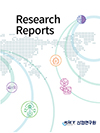Research Reports

For policy implication, the forecasting research is one of fundamental project to understand the impact of policy. Because of existence of business cycle as a characteristic of shipbuilding industry, forecasting shipbuilding industry has been one of the important research topic. However, like Martin Stopford’s opinion, forecasting shipping and shipbuilding industries are almost impossible. Even the forecasting report of Clarkson is criticized because of accuracy. After 2008 financial crisis, the long term expanded period was finished and down term has been continued. Korean shipbuilding industry also keeps to work out for survival. In order to restructure and reinforce industry, the long term forecasting is needed. In most cases, worldwide market research company reports are used but there is a limitation to apply forecasting value of worldwide reports on Korean shipbuilding industry. For this reasons, this research focused on the mid and long term forecasting Korean shipbuilding industry to compose industrial policies.
In this research, we mainly focused on four types of ships in this research: tanker, bulk carrier, container ship and LPG carries. For three types of ship (tanker, bulk carrier, container ship), the statistical analysis is conducted based on empirical economics methodologies. The monthly times series data and individual vessel data are compounded for statistical approach. The regression model is used for set a function of order-construction time difference. The hazard model analysis is conducted for estimating probability of scrapping. LPG carries, however, has limited observation for statical analysis so we set a forecasting model based on project analysis.
Shipping industry, the upstream industry of shipbuilding industry, is influenced by global economic status. Since ship order needs enormous funds, financial status situation is also important to decide ship order. Governmental policy, international trade treaty, advanced technology and environmental policy are necessary factors of shipbuilding industry analysis. There are enormous factors which need to be consider for forecasting model. But, only few variables are able to apply on forecasting model because of the measurement limitation and difficulty of calculating correlation.
We consider several variables, shipping volume per fleet, average speed, change of vessel size and environmental policy, to estimate shipping volume of each type of vessels. From this analysis, demand of ship by increased shipping volume is calculated. Replacement demand is calculated from scrapping probability model. The new ship construction is calculated from the time difference formula of time difference between order and construction. LNG carrier shipbuilding forecast is calculated by shipping volume and distance based on final investment decision of LNG projects. ISFEM market forecast is used for other type ships. The result shows that forecasting shipbuilding decreases after 6 years increases to 12 years from 6 years. The amount of recent 5 year construction amount is 34.5 million CGT per year. The forecasting amount until 2025 is 29.0 million CGT per year and the amount form 2026 to 2031 is 32.2 million CGT.
Recently, the market share of Korean companies increases as 32.5%. By using a recent 5-year market share, we calculate amount of ship construction during after 10 years. The average ship construction amount is forecast as 9.71 million CGT. This amount is similar with suitable amount of ship construction in Korea, which is considered as 9.2~10.5 million CGT. The assumption of this forecasting is that everything is constant as current situation including technology improvement and environmental restrictions.
We suggest several implications based on our results. First, stabilization of economic ecology with suitable size is necessary. Second, supporting projects to improve products value and shipbuilding technology is needed to be well-designed. In last, the regular forecasting project and training experts for response to upcoming uncertainty.

The works on this page are licensed for fair use under the provisions of the Korea Open Government License. See kogl.or.kr for more information.
Please enter the security text below
to prevent email collection
Please check the information of the person in charge.
연구과제 제안이 접수되었습니다.
신청이 접수되었습니다.


View Summary
코로나19 발생 이후 대부분의 고용 관심사가 항공 및 여행서비스, 음식·숙박 서비스 등 주로 서비스 업종에 집중된 상황에서 본 연구는 최근 그 중요성이 강조되고 있는 제조업의 고용변화를 살펴보았다. 분석에 따르면, 코로나19 이후 제조업 고용은 비교적 큰 충격 없이 빠르게 회복하는 모습을 보이고 있다. 제조업 고용은 서비스업에 비해 큰 충격 없이 유지되고 있고, 코로나19 직후 2020년 상반기에 약간 하락하였지만 하반기부터 회복 추세를 보이고 있으며, OECD 주요국의 제조업과 비교하여도 일본과 함께 고용 충격이 비교적 작게 나타나고 있다. 그러나 전반적으로 양호한 고용 성적에도 불구하고 제조업 내 특성 별로는 차이가 나타나는 것으로 보인다. 종사상 지위 별로 보면, 임시·일용직, 고용원이 있는 자영업자에서 고용 충격이 상대적으로 크게 나타났고, 상용직과 고용원이 없는 자영업자는 큰 충격이 없는 것으로 나타났다. 제조업 규모별로는 300인 이상의 경우 코로나 발생 초기 약간의 충격 이후 고용이 빠르게 반등하면서 코로나 이전보다 고용이 더 증가한 반면, 이보다 작은 규모의 제조업체들의 경우 고용 회복이 더디게 나타나고 있다. 고용의 중장기, 단기 추세선을 비교한 결과 제조업 업종에 따른 차이를 보였다. 코로나 발생 이전 3년간의 추세선을 2020년 1월부터 연장한 선과, 2020년 1월부터의 실제 자료를 이용한 단기 추세선을 비교한 결과, 의약품은 코로나19 발생 이전부터 시작하여 코로나19 발생 이후에도 견조한 증가세를 유지하고 있으며, 전자부품·컴퓨터, 기타운송장비, 가구는 코로나19 이후 오히려 고용 추세가 개선되었다. 그러나 다수 업종은 코로나 발생 이후 고용이 하락하였는데, 특히, 비금속광물, 1차금속, 금속가공 분야나 인쇄·기록매체 업종에서 하락이 상대적으로 크게 나타났다.
The following information is provided.
inform@kiet.re.krPlease complete the CAPTCHA below.
[전지적키에트시점] (Eng sub)심상치 않은
국내 대기업 움직임??
KIET 시점에서 보는 미래 로봇 산업 전망은
어떨까요?
경제전문가가 알려드립니다!
(산업연구원 박상수 실장)


